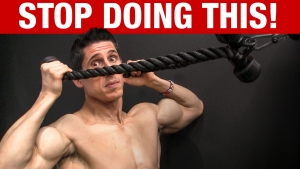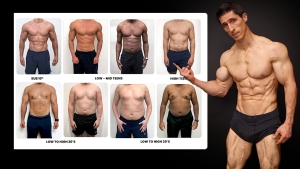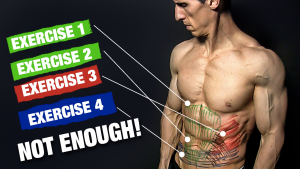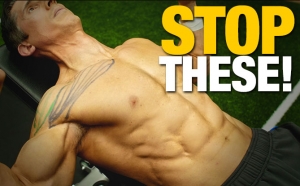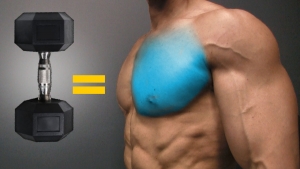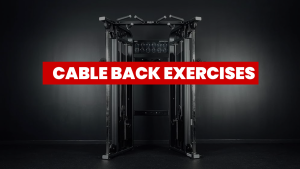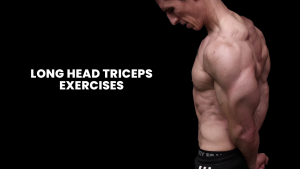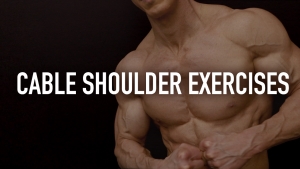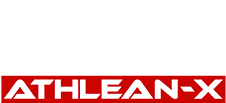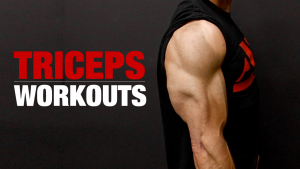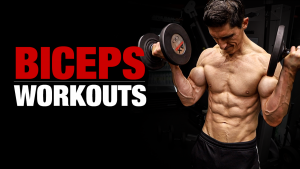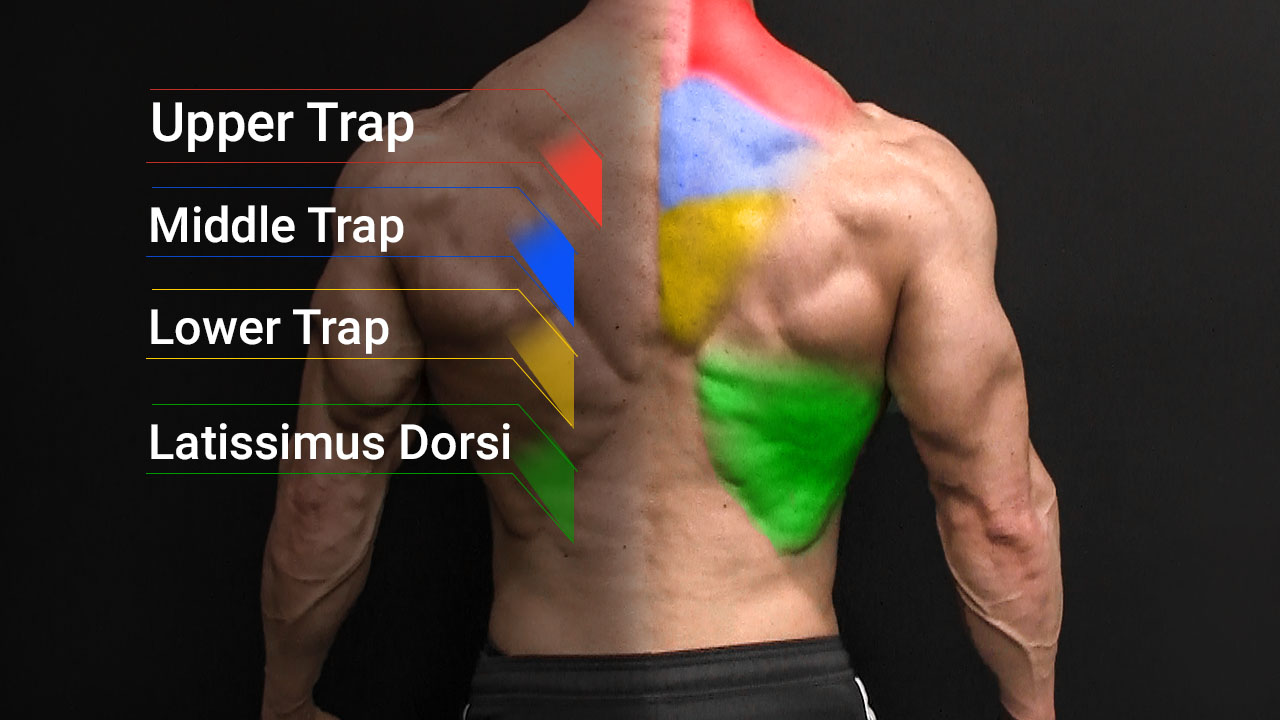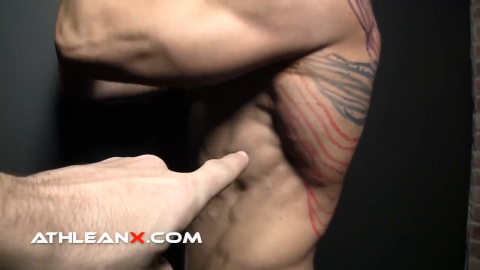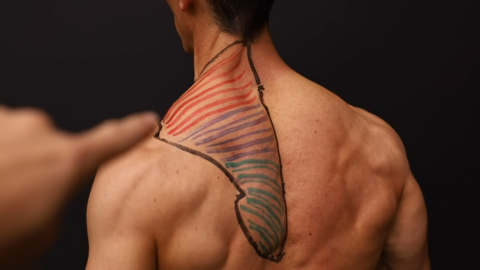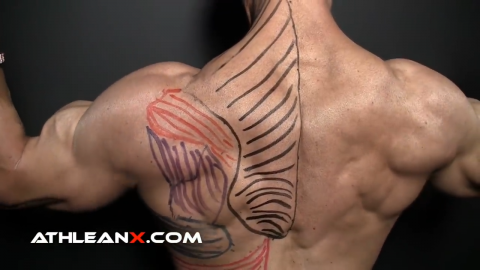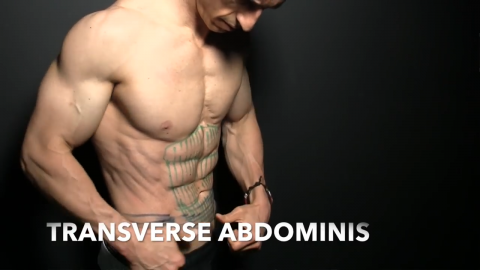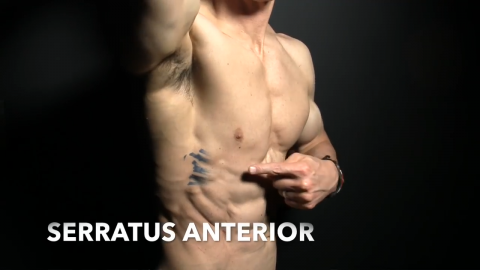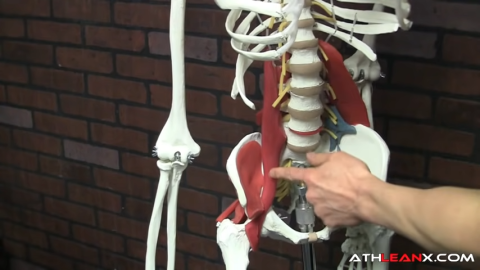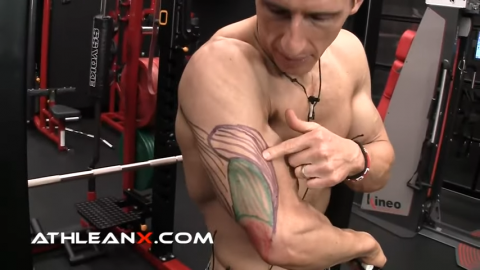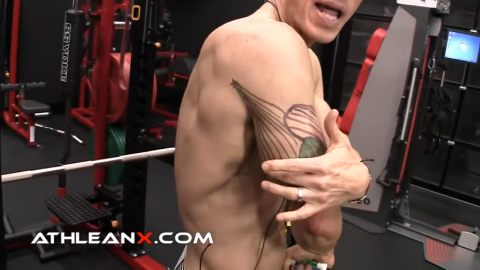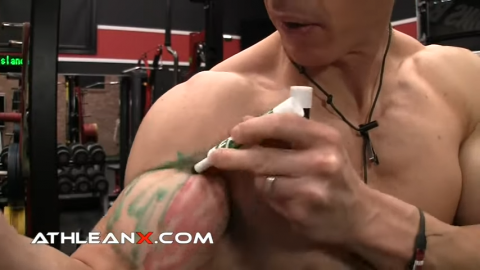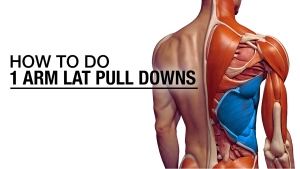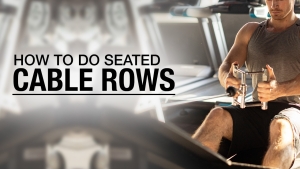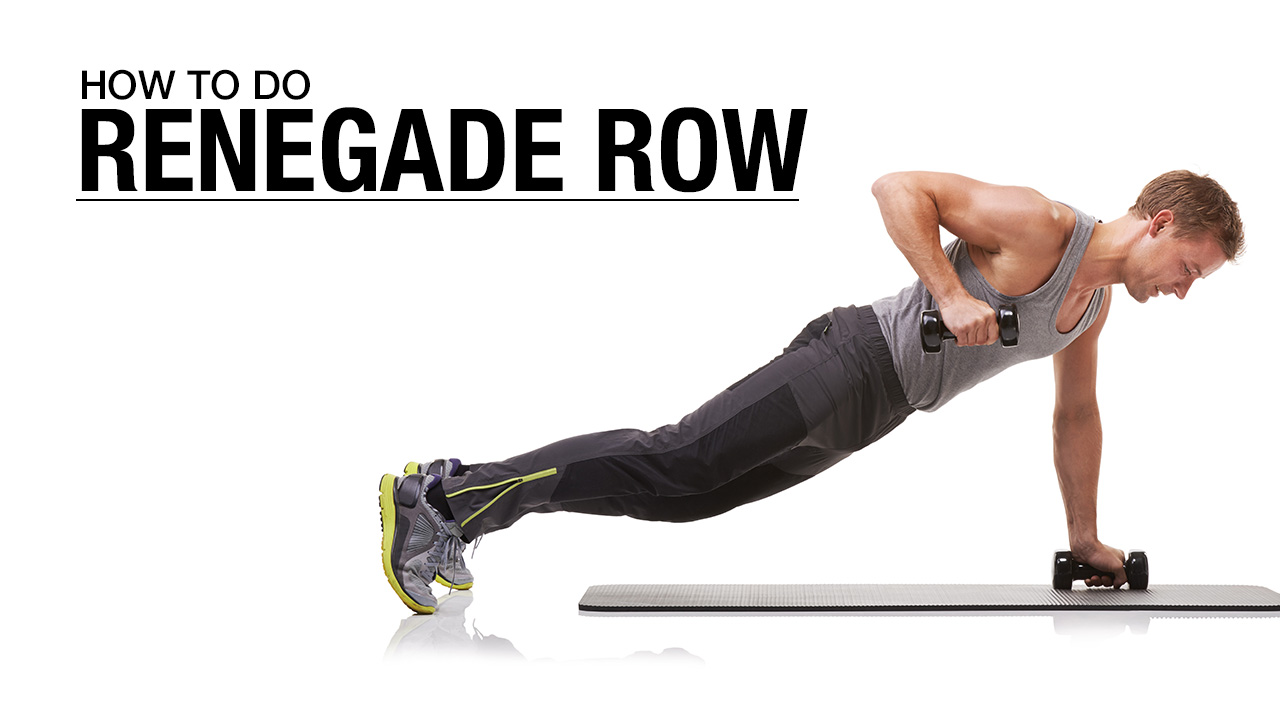
HOW TO PERFORM THE RENEGADE ROW CORRECTLY
The Renegade Row is a staple compound movement.
It targets the lats with a solid and basic rowing motion but hold on here because there’s more to consider.
The instability of the move shifts the challenge up the kinetic chain to your core.
If your core isn’t strong enough, you’re not going to be able to lift heavy weight, which limits your hypertrophy potential.
Plus, the floor cuts short the range of motion.
Unless you’re using your front delt to lift the dumbbell further, you’re missing out on that stretch reflex for max gains.
Despite the limitations of the entire movement sequence, the basic Renegade Row is still a great move for circuits or metabolic workouts.
It might not be my top choice for back hypertrophy, but it’s an effective exercise that deserves a spot in your routine.
With that said, let’s break down how to do the Renegade Row.
RENEGADE ROW: MUSCLES TARGETED
Understanding the muscles targeted during the Renegade Row is crucial for maximizing your results.
By establishing a strong mind-to-muscle connection, you can focus on engaging the right muscles from a strong baseline level, leading to better form, enhanced strength, and improved performance.
Let’s break down the key muscle groups involved in the Renegade Row exercise.
BACK
LATISSIMUS DORSI
The latissimus dorsi muscles are the heavy hitting larger muscles of your back, spanning a huge portion of your lower and mid-back.
Starting from your spine, these fan-shaped muscles attach to your upper arm bone (the humerus).
The lats give you that impressive “wing-like” appearance when flexed.
They also play a key role in several movements:
Shoulder Extension: This is bringing your arm down from a raised position or pushing it backward, like when you’re performing pull-ups or swimming.
Shoulder Adduction: You can compare this to flapping your arms like a bird. This brings your arm closer to your body.
Internal Rotation: This occurs when you turn your arms inward.
To effectively engage your lats, you can use the traditional Renegade Row.
For even more variety, consider Renegade Row variations like the Renegade Row Death Mark and Decline Renegade Row to enhance muscle activation and correct imbalances.
UPPER AND LOWER TRAPS
The trapezius muscles, or traps, are important for upper body functional strength and stability, especially in powerful exercises like the Dumbbell Plank Row.
The upper traps span from your neck to your shoulders and elevate your shoulder blades, which is essential for shoulder stability during upper body exercises like Shoulder Shrugs and overhead movements.
The lower traps run from the middle of your back to your lower spine, helping depress and retract the shoulder blades, maintaining proper alignment and spinal stability during Rows and Pull-Ups.
Building strength in both the upper and lower traps is vital for shoulder stability, preventing injury, and handling heavier weights with proper form.
During exercises like the Dumbbell Renegade Row, keeping your core tight and engaging the core muscles ensures proper position and maximizes muscle activation.
ROTATOR CUFF
The rotator cuff muscles are another muscle group that is engaged during the Renegade Row.
This exercise involves stabilizing the shoulder joint while performing the rowing motion, which requires the activation of the rotator cuff muscles.
These muscles—comprising the supraspinatus, infraspinatus, teres minor, and subscapularis—play a crucial role in maintaining shoulder stability and proper form throughout the movement.
During the Renegade Row, as you pull the dumbbell towards your body, the rotator cuff muscles work to keep the shoulder joint in place and prevent excessive movement, reducing the risk of injury and ensuring effective muscle engagement.
CORE MUSCLES
The rectus abdominis, obliques, and transverse abdominis work to stabilize the body during the Renegade Row exercise.
RECTUS ABDOMINIS
The rectus abdominis, often referred to as the six-pack muscle, extends from your ribcage down to your pelvis.
The vertically running fibers of the rectus abdominis provide elite-level back and core strength and stability, ensuring you stay steady and strong throughout the exercise.
EXTERNAL OBLIQUES
The external obliques are made up of diagonal fibers that run from your ribcage down to your pelvis, and they’re key for rotation and stabilization.
When you’re hitting the standard Renegade Row, your external obliques frame your rectus abdominis, enhancing your six-pack and boosting overall core strength.
Engaging your external obliques correctly is crucial for maintaining proper form and preventing injury.
Keep your core tight and focus on stability—this is what separates good form from great form, ensuring you get the most out of every rep.
INTERNAL OBLIQUES
The internal obliques run opposite to the external obliques, from your ribcage to your hips, angling toward your midline.
The internal obliques are essential for core tension and stability during the Renegade Row. Engaging these muscles correctly prevents form errors and maximizes workout effectiveness.
Your internal obliques keep your core tight and your position strong.
TRANSVERSE ABDOMINIS (CORE STABILIZER MUSCLES)
This often-overlooked muscle plays a crucial role in your core workouts.
The serratus anterior stabilizes your trunk by keeping the shoulder blades connected to the rib cage, which is necessary for maintaining a strong core during the Renegade Row.
HIP FLEXORS
When you’re hitting those Renegade Rows, don’t forget about your hip flexors—they’re key players in this exercise.
PSOAS
Let’s talk about the hip flexor muscles, specifically the psoas, and how they’re engaged during the Renegade Row.
The psoas muscle, running from your lower spine to your hip, plays a crucial role in this exercise.
When you’re in the plank exercise position for the Renegade Row, the psoas muscle is activated to maintain hip stability and alignment.
This muscle helps keep your hips from sagging or lifting, ensuring a strong and stable position from head to heels.
ARM MUSCLES
Your arm muscles also help by offering stability and support during Renegade Rows:
LATERAL HEAD OF TRICEPS
During Renegade Rows, the lateral heads of the triceps is essential for stabilization and control.
It helps stabilize the arm that stays on the ground, maintaining a solid push-up position.
When you row with one arm and return the dumbbell to the ground, the triceps extend the elbow, ensuring smooth and controlled movement.
MEDIAL HEAD OF TRICEPS
The medial head of the triceps muscle is also helpful for stability and control.
It stabilizes the arm on the ground, ensuring a solid plank position.
When you row and return the dumbbell, the medial head assists in elbow extension for smooth and controlled movement.
LONG HEAD OF TRICEPS
The long head of the biceps brachii assists in elbow flexion as you pull the dumbbell towards your body, allowing for smooth and controlled movement.
HOW TO DO THE RENEGADE ROW
Mastering the Renegade Row is going to lend itself to a fusion of strength and stability.
This exercise targets multiple muscle groups and requires proper form to maximize benefits and minimize injury risk.
Here’s how to perform the classic Renegade Row.
I’m also going to throw in a Renegade Row variation to help you get the most out of this exercise.
RENEGADE ROW

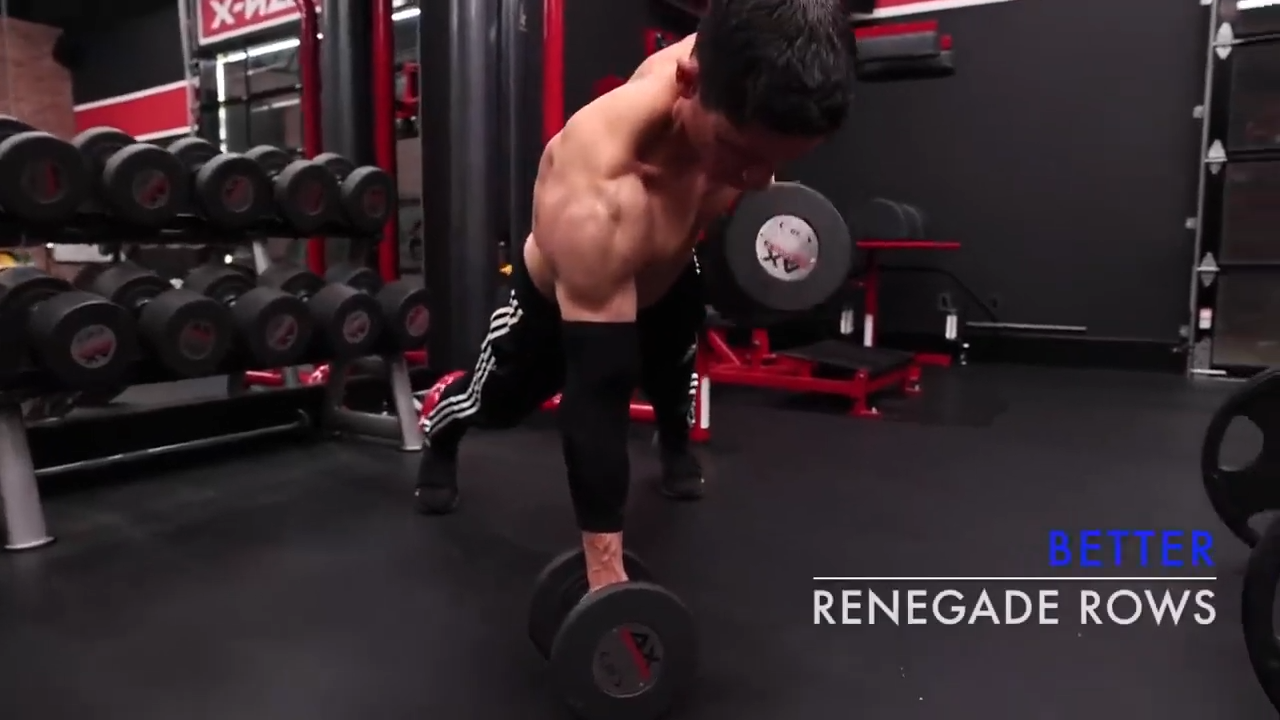
HOW TO DO RENEGADE ROWS:
- Get into a plank position on an exercise mat with your hands gripping the Renegade Row equipment: dumbbells or kettlebells. Hexagonal dumbbells are ideal for stability.
- Your body should be in a straight line from head to heels, maintaining a neutral position spine. Keep your feet hip-width apart for a stable base.
- Keep your core tight, engaging the core muscles to ensure proper form and core stability throughout the movement.
- Row the left dumbbell towards your hip while keeping your shoulder blades pulled back and down. Focus on the lats, trapezius muscles, and rhomboids for muscle engagement.
- Maintain shoulder stability by keeping your deltoids and upper back muscles engaged. Avoid letting your hips rotate – this is key for anti-rotational core strength.
- Slowly return the dumbbell to the floor to the original position, keeping control to maximize muscle activation and minimize injury risk.
- Repeat the movement on the other side, continuing to alternate from side to side.
WHAT MAKES IT EFFECTIVE: The Renegade Row is an effective back exercise because it targets the lats, rhomboids, and traps while simultaneously engaging the core for stability, providing a comprehensive workout that enhances both strength and muscle definition in the upper body.
RENEGADE ROW DUMBBELL DEATH MARCH

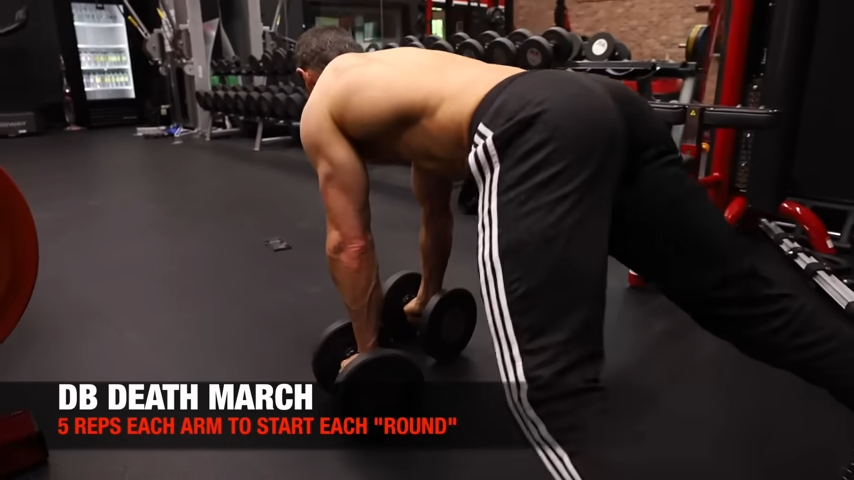
HOW TO DO THE RENEGADE ROW DUMBBELL DEATH MARCH:
- Get into a plank position with your hands on the dumbbells, feet shoulder-width apart, and hands shoulder-width apart.
- Ensure your body is in a straight line from head to heels, maintaining a neutral spine for proper form and spinal alignment.
- Keep your core tight. This ensures core stability and prevents your hips from rotating.
- If you have room to move, “walk” forward by lifting one dumbbell and planting it about a foot position in front of you with a neutral grip.
- Then alternate to the other arm, moving forward with each row. Continue to alternate from side to side.
WHAT MAKES IT EFFECTIVE: This movement introduces an additional layer of difficulty, significantly challenging your core and stabilizing muscles. As you lift and move each dumbbell, your core must work overtime to maintain stability and balance, engaging deep abdominal muscles and enhancing overall core strength.
RENEGADE ROW: COMMON MISTAKES
The Renegade Row is a powerful full-body exercise that targets multiple muscle groups, enhancing core stability and upper body strength.
However, improper execution can lead to ineffective workouts and a higher risk of injury.
Here are movement faults and common mistakes people make, how to avoid them, and correct form principles to get the most out of your Renegade Rows.
POOR STARTING POSITION
Starting with the wrong position is a common form issue that compromises the entire boundaries of exercise.
Ensure you begin in a solid plank position, with your body in a straight line from head to heels.
Hands should be shoulder-width apart on hexagonal dumbbells, and feet should also be shoulder-width apart to provide a stable base.
Continue to pay attention to poor body alignment and check your form between repetitions.
This initial setup is an essential movement for maintaining balance and excellent form.
HIPS INSTABILITY
Allowing your hips to rotate or sag is a common mistake people make.
This not only reduces the effectiveness of the exercise but also increases the risk of injury.
Keep your hips stable and level throughout this gym movement.
Engage your core muscles to maintain a tight and ideal pushup position.
INSUFFICIENT CORE ENGAGEMENT
Failing to keep your core tight leads to poor form, instability, and insufficient core strength.
The Renegade Row demands a strong core exercise to stabilize the body and prevent excessive movement.
Focus on engaging your core muscles, including the obliques and deep stabilization muscles, to maintain perfect form and avoid injury.
Keeping the core tight enhances the overall effectiveness of the exercise.
INCORRECT SHOULDER POSITION
Improper shoulder positioning can cause shoulder instability and strain.
Ensure your shoulder blades are pulled back and down, avoiding any shrugging or rounding forward.
Proper shoulder stability is critical for maintaining the correct position and preventing injury.
This engagement of the shoulder muscles, including the trapezius and deltoids, ensures proper alignment and muscle activation.
USING HEAVY ROW WEIGHTS
Starting with heavy weight can compromise your form and increase the risk of injury.
Begin with a light weight like a light weight kettlebell or body weight to master the form and movement before progressing to heavier loads.
Remember, proper form is more important than lifting heavy loads, especially in a challenging exercise like the Renegade Row.
Gradual progression in weight ensures safety and effectiveness.
LIMITED RANGE OF MOTION
Not utilizing a full range of motion limits the exercise’s effectiveness.
Ensure you row the dumbbell weights all the way to your hip, fully engaging the upper back muscles, including the lats and rhomboids.
A full range of motion maximizes muscle activation and development, providing the best results from your workout or exercise class.
This proper movement also helps in avoiding muscle imbalances.
POOR ALIGNMENT
Maintaining proper alignment from head to heels is crucial.
Avoid allowing your body to sag or pike, which can strain the entire spine and reduce the effectiveness of the exercise.
Keep your spine neutral, with your head in line with your body, to ensure proper alignment and minimize the risk of injury.
Correct body position is fundamental to performing the Renegade Row effectively.
NEGLECTING UNILATERAL BALANCE
The Renegade Row is a unilateral exercise, meaning it works one side of the body at a time.
Neglecting to balance both sides can lead to muscle imbalances.
Ensure you perform an equal number of reps on each side to promote balanced muscle development and core stability.
Balanced training ensures comprehensive muscle engagement and prevents asymmetrical strength.
RUSHING THE MOVEMENT
Performing the exercise too quickly can compromise form and reduce effectiveness.
Focus on controlled, deliberate movements, rowing the dumbbell with proper form and fully engaging the targeted muscles.
Slow and controlled movements enhance muscle engagement and reduce the risk of injury.
Taking your time with each rep ensures you get the most out of the exercise.
IGNORING VARIATIONS AND PROGRESSIONS
Sticking to the traditional Renegade Row without incorporating variations or exercise progressions can limit your progress.
Explore your favorite Renegade Row variations, such as Kettlebell Renegade Rows, Feet-Elevated Renegade Rows, or One-Arm Renegade Rows, to challenge your muscles in new ways and continue making gains.
Incorporating exercise variations ensures you keep your contemporary workout routines dynamic and challenging.
When it comes to back building exercises, the truth is that there are better exercises out there.
But that doesn’t mean the Renegade Row shouldn’t have a place in your exercise day workout routine.
You can use it as a complementary exercise to bigger and better exercises like Barbell Rows and Weighted Pull-ups.
If you’re looking for a training program that covers every muscle in the body, we’ve got you covered. Check out our ATHLEAN-X programs to see which is the best fit for your goals and fitness level.
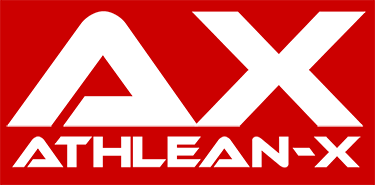
- Despite having some limitation, the Renegade Row is a solid choice for your back workout.
- Here’s how to do the Renegade Row with correct form:
- Begin in a strong plank with your hands gripping a pair of dumbbells. Hexagonal dumbbells are your best bet for stability here.
- Ensure your body forms a straight line from head to heels. Your spine should be neutral, and your feet should be hip-width apart to provide a stable foundation.
- Tighten your core. This will help maintain proper form and stability throughout the movement.
- Pull the left dumbbell towards your hip, keeping your shoulder blades retracted. Concentrate on engaging your lats, traps, and rhomboids.
- Keep your deltoids and upper back muscles engaged to maintain shoulder stability. Make sure your hips stay level and don’t rotate—this is crucial for building anti-rotational core strength.
- Lower the dumbbell back to the floor slowly and with control. This helps maximize muscle activation and reduces the risk of injury.
RENEGADE ROWS FAQS
The Renegade Row targets multiple muscle groups including the following:
It engages the core muscles, including the rectus abdominis, obliques, and transverse abdominis, providing significant core stability benefits and anti-rotational muscles strength.
The upper body muscles, particularly the upper back muscles like the lats, traps, and rhomboids, are heavily targeted with each rowing motion.
The deltoid muscles are also engaged, ensuring shoulder stability and reducing the risk of injury.
Additionally, the bicep muscles are activated during the rowing movement, while the triceps stabilize the arm that stays on the ground, enhancing control and form.
Grip strength is improved by holding dumbbells or kettlebells, especially when performing advanced kettlebell exercises.
Maintaining a stable base with your feet and hips is crucial for proper body positioning and maximizing the exercise's effectiveness.
This versatile exercise not only builds upper body strength but also enhances core stability, making it a valuable addition to any fitness routine.
Whether using dumbbells or kettlebells, the Renegade Row provides a comprehensive workout that challenges your entire body.
This is one of the most common questions about this exercise.
In short: Absolutely, the Renegade Row is great for your back!
Starting in a solid plank position, this versatile exercise targets the upper back muscles, including the lats, traps, and rhomboids.
You can also trade your dumbbells for kettlebells during this exercise.
Kettlebell Renegade Rows can add an extra challenge, improving grip strength and enhancing core stability benefits.
Keeping your core tight and your hips stable is crucial to prevent common mistakes and maximize muscle engagement.
This exercise also works the biceps and deltoids, providing comprehensive workout routines.
While it's not the top choice for hypertrophy, it’s an excellent double-duty exercise that boosts core strength and stability.
Incorporate it into your routine to build strength and prevent injury.
Alright guys, let's break the difference between Renegade Row and Dumbbell Row.
The Renegade Row starts in a plank position, requiring a core tight setup for extra core stability and anti-rotational strength.
This entire exercise engages upper back muscles, deltoids, and core. An effective kettlebell exercise like the Kettlebell Renegade Rows add grip strength challenges and further emphasize stability.
On the other hand, the Dumbbell Row is a more traditional horizontal pulling exercise, focusing primarily on upper back muscles without the same level of core engagement.
It allows for heavier weights and more isolated muscle activation.
Both are excellent exercises, but the Renegade Row offer a full-body conditioning exercise with core stability benefits, while the Dumbbell Row is great for targeting back muscles with heavier loads.
The Renegade Row is tough because it’s a full-body exercise that hits multiple muscles at once.
The starting position in a plank requires a core tight setup, challenging your core strength and stability.
This hybrid exercise demands grip strength, especially with Kettlebell Renegade Rows, and maintaining a stable base while keeping your hips stable is no joke.
The emphasis on stability and anti-rotational core strength means your core muscles, including the rectus abdominis and obliques, are working overtime.
Plus, balancing the weights exercise with proper form reduces the risk of injury.
It's a multifaceted compound exercise that targets your upper back muscles, deltoids, biceps, and more.
That's why it's a staple in advanced exercise routines, offering huge core stability benefits and overall strength development.
REFERENCES
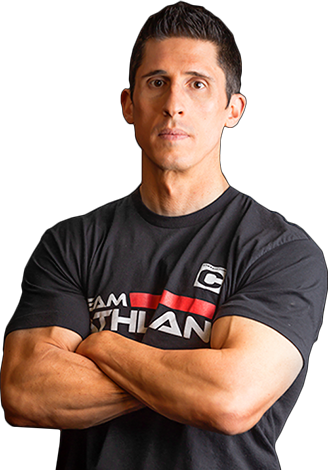
Jeff Cavaliere M.S.P.T, CSCS
Jeff Cavaliere is a Physical Therapist, Strength Coach and creator of the ATHLEAN-X Training Programs and ATHLEAN-Rx Supplements. He has a Masters in Physical Therapy (MSPT) and has worked as Head Physical Therapist for the New York Mets, as well as training many elite professional athletes in Major League Baseball, NFL, MMA and professional wrestling. His programs produce “next level” achievements in muscle size, strength and performance for professional athletes and anyone looking to build a muscular athletic physique.
